Abstract
In recent years, hybrid electric vehicles (HEVs) have increased significantly due to climate change and the demand for high-efficiency power sources. HEVs that combine an internal combustion engine (ICE) and an electric motor (EM) can improve the power output of the ICE and overcome the challenges of the insufficient battery life of electric vehicles. In this study, a parallel HEV with a power distribution mechanism is developed for energy saving and carbon reduction. The driver′s power demands are used as input sources, and a rule-based control strategy is used to determine the power distribution of the generator, EM, and ICE. The NEDC2000 driving cycle is used as the test benchmark to demonstrate the performance of the HEV. In comparison to ICE vehicles, the fuel efficiency of HEVs significantly improved. In addition, other parameters, including the average brake-specific fuel consumption (BSFC), brake-specific carbon monoxide emission (BSCO), and brake-specific hydrocarbons (BSHCs), were lower, which can effectively save fossil fuel and reduce air pollution.
1. Introduction
To reduce greenhouse gases, most developed countries have agreed to follow the requirements of the Paris Agreement, which has also brought about a complete revolution in the automotive industry. Developing pure electric vehicles powered by batteries, fuel cells, or other alternative fuels as power sources, such as biomass, hydrogen, liquefied natural gas, and ethanol, has been put into practice [1,2,3]. However, due to doubts about energy storage technology in batteries [4,5,6,7], hybrid electric vehicles (HEVs) are a recent focus at this stage. HEVs are a combination of an internal combustion engine (ICE) and an electric motor (EM) [8,9]. A suitable hybrid configuration of the ICE and the EM can not only overcome the challenges of insufficient battery life but also greatly improve the output power of the ICE [10,11,12].
Toyota launched the first-generation HEVs in 1997, which saved nearly twice the fuel consumption compared to ICE vehicles [13]. Toyota developed a good energy management strategy to make the ICE run in the best-efficiency zone, thereby improving the exhaust emissions. The Toyota hybrid system consists of a nickel-metal hydride battery and an EM [14], as well as a planetary gear-type power integration distribution mechanism, which can provide excessive power to recharge the battery and reduce energy loss. A research report from TESLA Motors showed that HEVs are superior to ICE vehicles in terms of performance, efficiency, and pollutant emissions [15]. Powell et al. [16] established a component dynamic theory module for HEVs and analyzed the dynamic model of system components through MATLAB/Simulink to obtain optimal power of the components. Lin et al. [17] adopted a rule-based control strategy and dynamic programming as an energy management controller to reduce the fuel consumption rate of HEVs. Schouten et al. [18] used a fuzzy logic library for the energy management and power distribution in HEVs to improve fuel economy and overall performance. In addition, Langari et al. [19] put forward another point of view to explain that HEVs using fuzzy logic controllers should have different energy management methods in different driving modes to effectively achieve energy saving and low pollution. Bathaee et al. [20] proposed that using a hierarchical structure to manage the energy control of HEVs can significantly reduce fuel consumption and NOx emissions. Recently, Qi et al. [21] also discussed the hierarchical structure along with a novel deep-learning algorithm for HEV energy management, with the aim of reaching the optimal power distribution and lower fuel consumption. Miller [22] discussed the transmission mechanism in different types of vehicles, analyzed their dynamic models of electronically controlled continuously variable transmissions (eCVTs), and evaluated mode-switching efficiency for the vehicles. Hoeijmakers and Ferreira [23] described the electronic transmission mechanism used in HEVs, which can also enable the ICE to operate at better efficiency and increase fuel efficiency. Duoba et al. [24] found that the HEV architecture has the potential to develop high fuel economy and that more rigorous control strategies can enable the system to achieve low fuel consumption. Chen et al. [25] proposed a rule set using a fuzzy logic controller for dynamic programming and analysis. The control method showed positive results in achieving optimal power distribution for parallel HEVs under various driving conditions and also avoided power loss during switching modes. In addition, a similar method based on a rule set was also applied to medium- and heavy-duty vehicles, with the same target of achieving a balance between fuel consumption and vehicle performance [26]. A light-duty 48 V HEV was also taken into account with model simulation and validation using the Matlab/Simulink/Stateflow tool [27]. Optimization is also one of the effective ways; several typical HEV models were compared using rule-based control methods [28], and BSFC maps were drawn and used to compare [29]. Lee et al. [30] provided detailed information about the control strategy of a real vehicle, Hyundai Ioniq Hybrid, which is particularly useful for engineers to properly investigate algorithm innovation and optimization, while driving-mode switching optimization is the key factor to determine smooth operation as well as HEV performance according to Zeng et al. [31].
In addition, according to different power transmission and distribution methods, HEVs can be divided into parallel and series types [32,33,34]. Oh et al. [35] used MATLAB/Simulink to conduct optimization analysis with different algorithms for parallel and series HEVs. The results showed that the fuel economy efficiency and regenerative braking energy recovery of parallel HEVs are better than those of series HEVs. The ICE and EM of a parallel system are connected to the transmission shaft through a power integration device or a transmission device. The vehicle can be driven by the ICE and the EM simultaneously or independently. Similarly, Geng et al. [36] investigated series-parallel HEVs controlled by a novel energy management algorithm; the characteristics of the method were investigated, and then simulation was carried out. The research indicated significant improvement in fuel economy and energy conversion. In addition, simulation based on a complex electromechanical system with a planetary gearbox was conducted by Dermentzoglou [37]. Two cases in this study were compared in terms of differently developed mathematical models. Several kinds of HEV configuration and control techniques were discussed by Bayindir et al. [38]. The pros and cons of each kind were analyzed to find the most suitable energy control strategy. In the same way, Xue et al. [39] introduced and classified various types of energy management strategies based on different key factors, such as the mechanism and components of HEVs and external power charging. When the ICE was operated in the optimal operating range for an extended period under different conditions through proper dynamic programming [40] and a power-management strategy [41], the fuel economy of parallel hybrid vehicles was exceptional. Suhail et al. [42] proposed a novel method approaching energy management while taking into account battery performance. A fuzzy logic controller and MATLAB/Simulink were applied for simulation purposes, and then the results were compared to verify the efficiency of the two intelligent control methods mentioned. Li et al. [43] successfully reduced fuel consumption and maintained the ICE and battery’s SOC in the optimal working range based on an optimized K-means clustering algorithm. Recently, control strategies for grid distribution for electric vehicles or plug-in HEV charging have also been taken into account. Boglou et al. [44,45] introduced this topic using a fuzzy theory dealing with several charging management issues, such as distance to the charging station and battery charging delay time, and achieved positive results.
During the driving process, if the control system of the HEV fails to switch the power mode smoothly, the driving would be delayed and the passengers would feel uncomfortable. A complete set of corresponding energy control rules and management control strategies for parallel HEVs according to driving power requirements can improve this issue [46,47]. Therefore, this study uses MATLAB/Simulink to create a computer simulation program and verified the energy management control strategy of the system based on driver demand. First, an HEV energy management control strategy is established by dynamic equations. Then, the model parameters according to the test data and the response model comparison are adjusted. After that, the energy management control strategy is used to control the power of the distribution system. The switching points of different power output modes are determined according to the battery’s SOC and the optimal efficiency region of the ICE. Finally, the fuel efficiency, average brake-specific fuel consumption (BSFC), brake-specific carbon monoxide emission (BSCO), and brake-specific hydrocarbon (BSHC) emission performance of the newly designed module are checked and compared to those of ICE vehicles using the NEDC2000 vehicle model.
The paper comprises the following sections: Materials, including software, hardware, and the rule set, are first introduced in Section 2. The mechanism of HEVs with various components, the energy control module, and power distribution types with several operation modes are also explained in detail in this section. In Section 3, the results are compared with the NEDC2000 driving cycle to guarantee the success of the proposed control strategy. A detailed discussion of various HEV components is conducted based on the positive results. In addition, a comparison between HEVs and ICEs based on the four indexes mentioned before is drawn. Finally, all the findings are summed up in Section 4, as well as proposed future work.
2. Materials and Methodology
2.1. Device Architecture
This platform uses a CAN bus to control the data transmission between chips. For the energy management module, the development system uses MotoHawk and the chip uses Motorola MPC555. The rest of the control system model uses Simulink/Stateflow and MotoTron. This research procedure is divided into three steps, as mentioned earlier. Then, the system performance is tested according to the NEDC2000 vehicle mode to verify the effectiveness of the energy management module.
In this study, the power source of the HEV includes an ICE and an integrated motor/generator, as shown in Figure 1. A mechanism of power integration and distribution is also needed to provide the required power output and ensure smooth operation of the system. It helps connect or disconnect the two power sources, which are the ICE and the EM, in various driving modes. The system power is distributed by the energy management module. The energy management control strategy uses the driver’s accelerator and brake signals as the power demand and feeds back the power of each power element, the battery’s SOC, and the actual vehicle speed to determine the driving mode.
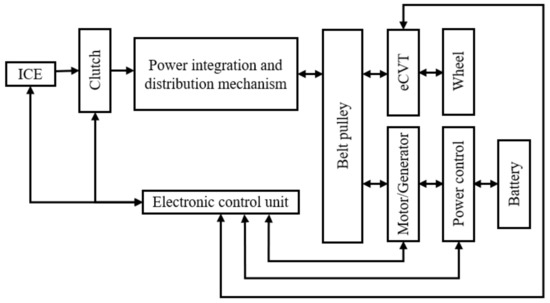
Figure 1.
The architecture diagram of the HEV system.
The eCVT acts as a stepless speed changer to control the output torque caused by different driving conditions. When the power demand is medium, it is driven by the ICE, and the generator is used for excessive power absorption to avoid the low-efficiency area of the ICE. When the power demand is high, it is driven by both the ICE and the EM. At this time, the ICE still maintains the optimal operating point. Therefore, the ICE of this system is maintained in the high-efficiency region once it starts.
2.2. Energy Management Control Strategy with Operation Mode
The energy management control strategy proposed in this study aims to meet the low-, medium-, and high-load requirements. At low load, the EM outputs the power to meet the need of the vehicle. All power is provided by the ICE at medium load, and the extra power exceeding the driver′s demand will drive the generator to charge the battery. The ICE is maintained in the optimal operation area at high load; the EM provides different power according to the power demand, and the two power sources simultaneously provide power to meet the power demand of the vehicle. As long as the ICE is in operation, the optimum operating point is always maintained at low, medium, or high load.
The power source of this HEV can be divided into three types: motor drive, ICE drive, and ICE plus motor drive. According to the power distribution principle combined with the rule-based control method, the overall power demand can be divided into four energy management control strategies: motor output, engine output, dual output, and rechargeable battery when there is no power demand. Rule-based control rules convert the driver’s throttle signal into power demand. The energy management controller determines the energy distribution according to the power demand. There are four types of energy distribution, which are described as follows:
- (1)
- Motor output: The control flow is shown in Figure 2. The operating mode switching point is determined according to the maximum power that the electric motor can output and the efficiency curve of the internal combustion engine. When the demand power does not exceed the switching value of the maximum output power of the electric motor, the electric motor provides power to meet the vehicle’s power demand. Conversely, when the required power exceeds the switching value of the maximum output power of the electric motor, it switches to the ICE mode. During the switching process, the ICE rises to the operating point established by the system in the shortest time. The operating point varies depending on the SOC. As the power output of the ICE rises, the energy management controller controls the output of the motor power. The driver does not feel the vibration caused by the engagement of the two power sources when the mode is switched, as shown in Figure 2.
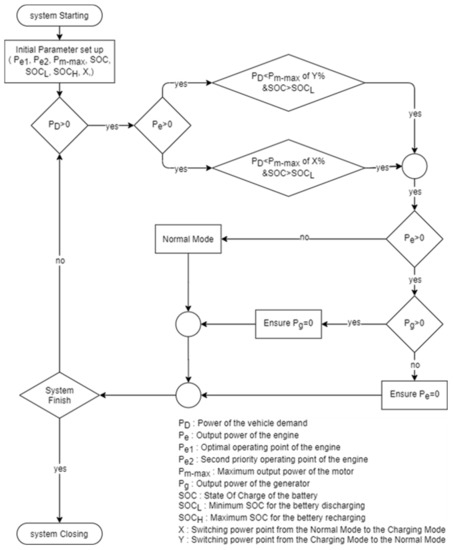 Figure 2. Flowchart of the motor output control strategy.
Figure 2. Flowchart of the motor output control strategy.
- (2)
- Engine output: The control flow is shown in Figure 3. The ICE mode is activated when the driver′s power demand exceeds the switching value of the maximum output power of the electric motor and the SOC is also within the rechargeable range. This allows for excess power to be charged back to the battery using the generator. In addition, when the driver’s power demand exceeds the optimal operating point of the internal combustion engine, a transition from the generator state to the powering electric motor state occurs. Finally, the pure combustion engine mode can also charge the battery to the SOC reference value when the vehicle is under low load.
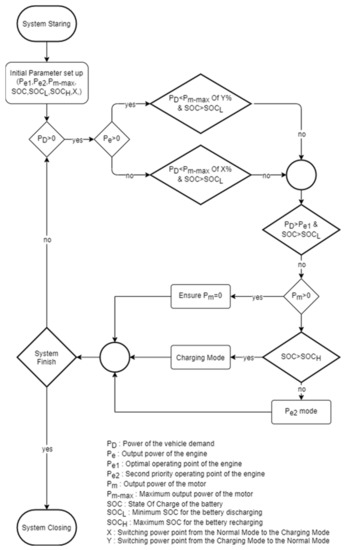 Figure 3. Flowchart of the engine output control strategy.
Figure 3. Flowchart of the engine output control strategy.
- (3)
- Dual output: The control flow is shown in Figure 4. When the driver’s power demand exceeds the optimal operating point of the ICE and the SOC is greater than the reference value, the electric motor is used to assist the ICE to meet the vehicle’s power demand.
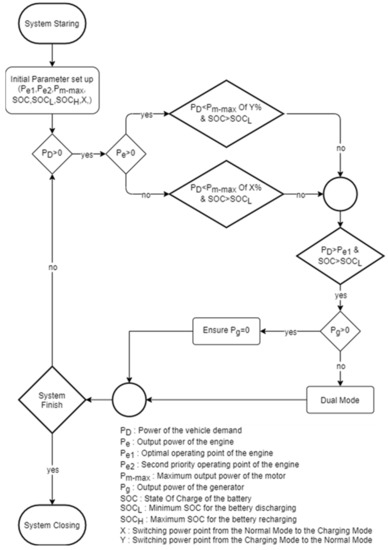 Figure 4. Flowchart of the dual-output control strategy.
Figure 4. Flowchart of the dual-output control strategy.
- (4)
- Regenerative braking: The control flow is shown in Figure 5. When the driver depresses the brake pedal, the energy management controller determines that the system is in the deceleration mode. At this time, the ICE does not run and the electric motor is driven by the inertia of the vehicle to become a generator. If the SOC is already greater than the reference value, the pure braking mode is used without charging. Moreover, the vehicle speed is judged first. If the vehicle speed is greater than the switching value of regenerative braking, the electric motor is turned on to absorb the braking energy and recharge the battery.
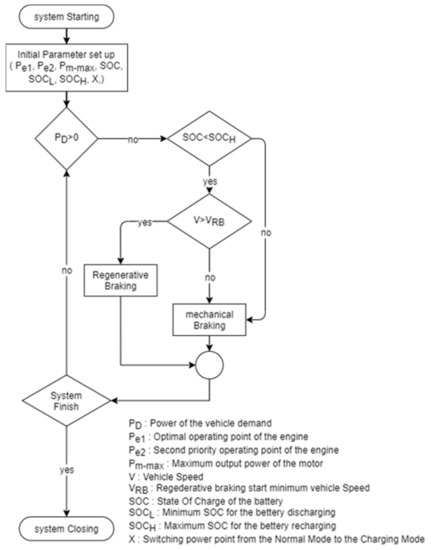 Figure 5. Flowchart of the regenerative braking control strategy.
Figure 5. Flowchart of the regenerative braking control strategy.
The four types of rule-based systems mentioned earlier are established using Simulink/Stateflow, and the if-else control method is applied through a graphical program. During the simulation process, the control strategy power flow is observed to confirm the completed Stateflow control. MotoHawk modules are connected for communication signals with surrounding components. The full control program is then sent to the chip through MotoTron, and MotoTune, real-time monitoring software, is used to confirm the internal parameters of the ECU for actual platform verification.
The operation mode switching is explained in Figure 6. Mode 1 is the motor output, Mode 5 is the engine output, and Mode 8 is the dual output. When switching from Mode 1 to Mode 5, Mode 2 is introduced to confirm that the ICE is maintained at the operating point and then turns the electric motor to the generator for charging. When switching from Mode 5 to Mode 8, Mode 6 is introduced to confirm the operating point of the ICE and switches the generator to the electric motor to supplement additional power. When returning from Mode 8 to Mode 5, Mode 7 is used to confirm the operating point of the ICE and switches the electric motor to the generator for charging. When returning from Mode 5 to Mode 1, Mode 4 is used to confirm that the generator is turned off and the electric motor is turned on. Then, the system enters Mode 3 to confirm that the ICE is completely shut down.

Figure 6.
HEV’s operation-mode-switching diagram.
3. Results and Discussion
This study used the NEDC2000 driving cycle to confirm the success of the energy management control strategy in an HEV. The initial value, maximum value, and minimum value of the SOC were set to 60, 80, and 40, respectively. Figure 7 shows the simulation result compared to that of the NEDC2000 driving cycle. The solid line indicates the driving speed of the NEDC2000, and the dotted line indicates the output speed. As shown in Figure 7, the motor mode is between 0 and 250 s. From the 250th s, since the power demand exceeds the maximum power in the motor mode, Mode 2 is used to switch to the ICE mode. At the 253rd s, it is successfully switched to the ICE mode and controls the generator to adjust the output power. At the 310th s, the system determines that the power demand is less than the minimum output of the ICE mode, so it switches to Mode 4 to adjust the connection between the internal combustion engine and the generator. At the 313th s, it is confirmed that the generator is off, so Mode 3, the induction mode, starts the electric motor and connects the power to the ICE. At the 390th s, Mode 2 is used again to enter the ICE mode from the motor mode. At the 516th s, the system determines that the required power exceeds the maximum power of the ICE mode, so it directly switches to the dual-power mode. However, considering the actual platform operating conditions, Mode 6 is still added to ensure that the generator is turned off as a protection component system. In the 546th s, the system determines that the required power is less than the minimum power of the dual power, so Mode 7 is used to switch off the electric motor to the ICE mode. At the 562nd s, Mode 3 and Mode 4 are used again to return from the internal combustion engine mode to the motor mode.
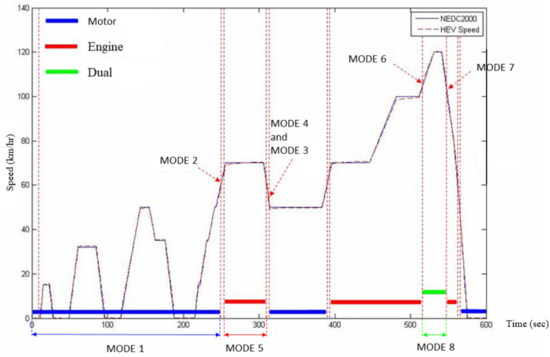
Figure 7.
Speed map with the NEDC2000 driving cycle.
In the proposed energy management control strategy, to avoid the waste of energy caused by the ICE being turned on and off several times, different switching points are set, as explained earlier. At the same time, to make effective use of the characteristics of the integrated motor/generator, different switching points are also set during the switching process between the engine mode and the dual-power mode, as well as switching between the electric motor and the generator. Switching too often may cause the energy being produced and provided to the HEV in an ineffective way.
Figure 8 shows the speed of each component in the NEDC2000 driving cycle, from top to bottom: the integrated motor/generator, ICE, power distribution mechanism, eCVT, and wheels. The period of 0–250 s is the electric motor mode, 253–310 s is from the electric motor mode to the ICE mode, and 516–546 is the dual-power mode. When the system is in Mode 1 operation, the EM provides power to the vehicle. After 250 s, the controller determines that the power demand is higher than that of the maximum output of the EM. Therefore, the ICE starts to provide power instead of the EM. During Mode 5, from the 253rd to the 310th s, the EM becomes the generator, and a negative value indicates that the generator is in operation. From the 516th to the 546th s, Mode 8, with the combination of both the EM and the ICE, simultaneously provides the required power to the vehicle and ensures the optimal operating point of the ICE. Thus, the control strategy contributes to the power demand and fuel efficiency of the HEV. Finally, when a deceleration signal is received, the motor speed decreases gradually and the whole system speed reaches zero.
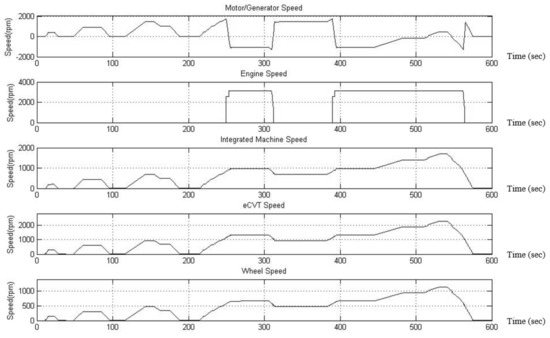
Figure 8.
Output speed diagram of various components in the NEDC2000 driving cycle.
Figure 9 depicts the output torque of each element in the NEDC2000 driving cycle. The output torque of the electric motor and the generator is the external load transmitted back through the power integration distribution mechanism. The ICE can output a stable torque from 250 to 313 s and 390 to 565 s. This is because the external load transmitted from the eCVT to the power integration distribution mechanism is adjusted to a fixed output. In the rest of the time, due to the activation of the braking mode, the power integration distribution mechanism does not allow the power to be transmitted to the ICE, so the torque received is 0. In addition, Figure 9 shows that the output torque of the power integration distribution mechanism is more stable than that of the eCVT and the wheel output torque is twice the reduction ratio of the eCVT.
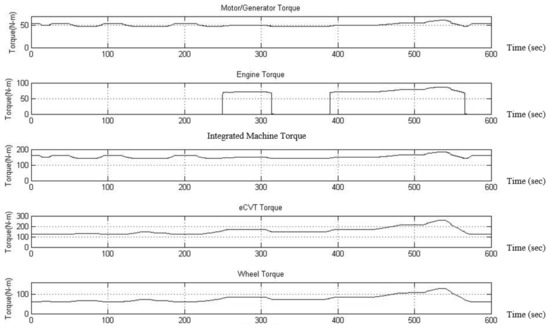
Figure 9.
Output torque diagram of various components in the NEDC2000 driving cycle.
Figure 10 is a BSFC diagram of the output of the internal combustion engine in the NEDC2000 driving cycle. The first start time of the ICE is 70 s, and the time ratio of maintaining the optimal operating point region is 77.1%. The second start time is 186 s, and the time ratio of maintaining the optimal operating point region is 91.9%. During the NEDC2000 driving mode, the proportion of the internal combustion engine falling in the optimal operating area is 87.9%, and the blue drop point indicates the operating area of the internal combustion engine. Since the eCVT is used to adjust the deceleration ratio of the output to the wheels, the operation area of the ICE falls within the most fuel-efficient range, without affecting the performance of the HEV, which greatly reduces fuel consumption. Figure 11 shows the emission map of various pollutants of the internal combustion engine, including BSCO and BSHCs.
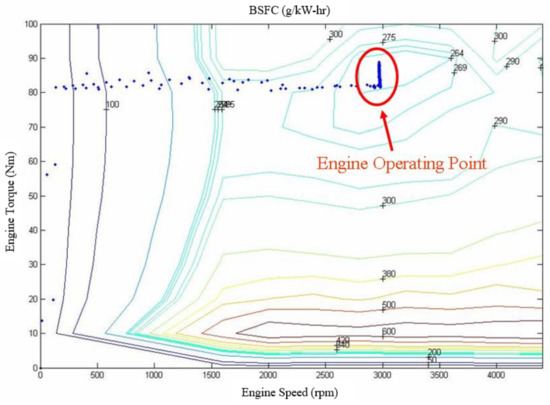
Figure 10.
ICE BSFC diagram with the NEDC2000 driving cycle.
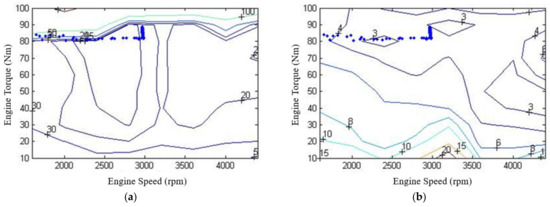
Figure 11.
ICE pollutant emission map with the NEDC2000 driving cycle: (a) brake-specific carbon monoxide emission (BSCO) and (b) brake-specific hydrocarbons (BSHCs).
Figure 12 shows the SOC diagram and the voltage output diagram of the battery in the NEDC2000 driving cycle. From the 253rd to the 310th s, the ICE mode is used, where the electric motor is turned into a generator. At this time, the vehicle speed is low and the generator must consume power to reduce the load on the motor to reduce the vehicle speed. From the 393rd to the 516th s, the ICE mode is used and the kinetic energy is converted into electrical energy to recharge the battery, so the SOC value slowly rises. From the 547th to the 562nd s, it switches from the dual-power mode to the ICE mode and the electric energy is also recharged to the battery.
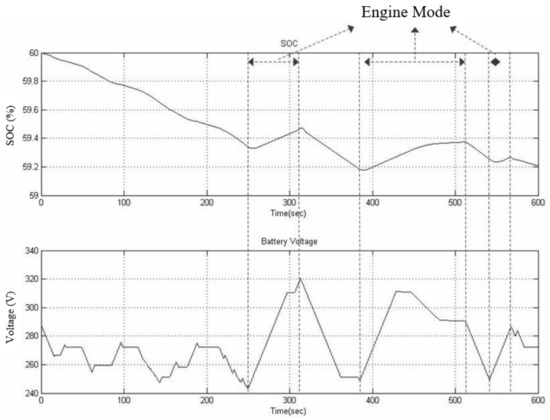
Figure 12.
Battery voltage and SOC diagram with the NEDC2000 driving cycle.
Table 1 shows the calculation results of the HEV and the ICE with the NEDC2000 driving pattern. The inspection items include the fuel economy and the average BSFC, BSCO, and BSHC values. The fuel economy uses the grams consumed by the BSFC per power hour, and the average value of the output power of the ICE and the BSFC integral is taken as the fuel consumption estimation.

Table 1.
Datasheet of HEV experimental results.
From the results, it is determined that the fuel economy of an HEV is much better than that of an ICE, by up to 2.1 times. In addition, the average BSFC, average BSCO, and average BSHCs of an HEV are better than those of an ICE. This is because the integrated power distribution system and eCVT maintain the stable output of the ICE in the highest-efficiency region and do not increase the load of the ICE due to the increased load. An effective use of energy management control strategies can indeed improve the increased load on the ICE caused by the mode-switching problem.
4. Conclusions
In this study, a rule-based control method was used to set the energy management control strategy for HEVs and an eCVT was used to adjust the output torque of the ICE to maintain it in the optimal operating region. In addition, the power distribution was determined according to the driver’s demand and the battery’s SOC. The MATLAB/Simulink tool was used for experimental construction, and the integrity of the control strategy was verified through the NEDC2000 driving mode. The simulation and experimental results confirmed that the operating point of the ICE falls within the optimal BSFC range and the fuel economy and the average BSFC, BSCO, and BSHCs are all better than those of the ICE. Based on the simulation and experimental results, the following conclusions were drawn:
- 1.
- The rule-based system coupled with the power integration and distribution mechanism achieves four energy management strategies, which are motor output, engine output, dual output, and regenerative braking.
- 2.
- The energy management control strategy takes into account all the conditions that may be encountered in driving. Introducing more power engagement modes can increase the smoothness of power delivery.
- 3.
- The control strategy based on the driver’s power demand is not only more rigorous in structure but also closer to the actual vehicle operation mode than speed based. This method effectively avoids the occurrence of unsmooth power switching.
- 4.
- Compared to traditional vehicles, HEVs can greatly save fuel consumption and reduce exhaust emissions. HEVs can meet low-carbon requirements and future carbon emission restrictions.
For future work, continuous adjustment and verification are required to establish a perfect control strategy. It is expected that the control strategy will be complete and implemented on a real vehicle. Simulation and experimental data can be clearly compared, and the method can contribute to the reduction in greenhouse gas emissions. Energy management requires long-term verification tests. More aspects and accurate algorithms for precise control need to be studied so that energy management can be more comprehensive and complete.
In addition, improvement in the weight and transmission efficiency of the mechanism needs to be considered as these are also directly related to the performance and fuel consumption of the vehicle. The transmission ratio of each part of the vehicle can also be discussed. If the final transmission ratio is too high, the speed will not be high, and if the final transmission ratio is too low, the speed can be increased but the torque will be insufficient. Slippage of the eCVT drive belt is also one of the critical factors connected to the overall performance, limiting the range of the transmission ratio within the workable range to improve the operational reliability. Additionally, an analysis of power loss and regenerative braking efficiency needs to be carried out.
Author Contributions
Conceptualization, K.D.H.; methodology, K.D.H. and P.-T.C.; software, M.-K.N. and P.-T.C.; validation, M.-K.N. and P.-T.C.; formal analysis, M.-K.N. and P.-T.C.; investigation, M.-K.N. and P.-T.C.; resources, K.D.H.; data curation, P.-T.C.; writing—original draft preparation, M.-K.N. and P.-T.C.; writing—review and editing, M.-K.N. and P.-T.C.; visualization, K.D.H.; supervision, K.D.H. All authors have read and agreed to the published version of the manuscript.
Funding
This research received no external funding.
Institutional Review Board Statement
Not applicable.
Informed Consent Statement
Not applicable.
Data Availability Statement
Not applicable.
Conflicts of Interest
The authors declare no conflict of interest.
References
- Man, H.; Liu, H.; Xiao, Q.; Deng, F.; Yu, Q.; Wang, K.; Yang, Z.; Wu, Y.; He, K.; Hao, J. How ethanol and gasoline formula changes evaporative emissions of the vehicles. Appl. Energy 2018, 222, 584–594. [Google Scholar] [CrossRef]
- Ye, M.; Sharp, P.; Brandon, N.; Kucernak, A. System-level comparison of ammonia, compressed and liquid hydrogen as fuels for polymer electrolyte fuel cell powered shipping. Int. J. Hydrog. Energy 2022, 47, 8565–8584. [Google Scholar] [CrossRef]
- Nguyen, M.K.; Sangeetha, T.; Chen, P.-T.; Hsu, T.-W.; Yan, W.-M.; Yang, C.-J.; Huang, K.D. High performance zinc–air fuel cell with zinc particle fuel and flowing electrolyte. J. Chin. Inst. Eng. 2021, 44, 842–850. [Google Scholar] [CrossRef]
- Liu, K.; Li, K.; Peng, Q.; Zhang, C. A brief review on key technologies in the battery management system of electric vehicles. Front. Mech. Eng. 2019, 14, 47–64. [Google Scholar] [CrossRef]
- Wang, Q.; Jiang, B.; Li, B.; Yan, Y. A critical review of thermal management models and solutions of lithium-ion batteries for the development of pure electric vehicles. Renew. Sustain. Energy Rev. 2016, 64, 106–128. [Google Scholar] [CrossRef]
- Panchal, S.; Mathew, M.; Dincer, I.; Agelin-Chaab, M.; Fraser, R.; Fowler, M. Thermal and electrical performance assessments of lithium-ion battery modules for an electric vehicle under actual drive cycles. Electr. Pow. Syst. Res. 2018, 163, 18–27. [Google Scholar] [CrossRef]
- Lu, M.; Zhang, X.; Ji, J.; Xu, X.; Zhang, Y. Research progress on power battery cooling technology for electric vehicles. J. Energy Storage 2020, 27, 101155. [Google Scholar] [CrossRef]
- Martinez, C.M.; Hu, X.; Cao, D.; Velenis, E.; Gao, B.; Wellers, M. Energy management in plug-in hybrid electric vehicles: Recent progress and a connected vehicles perspective. IEEE Trans. Veh. Technol. 2017, 66, 4534–4549. [Google Scholar] [CrossRef]
- Sabri, M.F.M.; Danapalasingam, K.A.; Rahmat, M.F. A review on hybrid electric vehicles architecture and energy management strategies. Renew. Sustain. Energy Rev. 2016, 53, 1433–1442. [Google Scholar] [CrossRef]
- Chen, P.-T.; Pai, P.-H.; Yang, C.-J.; Huang, K.D. Development of transmission systems for parallel hybrid electric vehicles. Appl. Sci. 2019, 9, 1538. [Google Scholar] [CrossRef] [Green Version]
- Hu, J.; Jiang, X.; Zhen, L. Design and analysis of hybrid electric vehicle powertrain configurations considering energy transformation. Int. J. Energy Res. 2018, 42, 4719–4729. [Google Scholar] [CrossRef]
- Zhuang, W.; Li, S.; Zhang, X.; Kum, D.; Song, Z.; Yin, G.; Ju, F. A survey of powertrain configuration studies on hybrid electric vehicles. Appl. Energy 2020, 262, 114553. [Google Scholar] [CrossRef]
- Lave, L.B.; MacLean, H.L. An environmental-economic evaluation of hybrid electric vehicles: Toyota’s Prius vs. its conventional internal combustion engine Corolla. Transport. Res. Part D 2002, 7, 155–162. [Google Scholar] [CrossRef]
- Sasaki, S. Toyota’s newly developed hybrid powertrain. In Proceedings of the 10th International Symposium on Power Semiconductor Devices and Ics, Kyoto, Japan, 3–6 June 1998. [Google Scholar] [CrossRef]
- Eberhard, M.; Tarpenning, M. The 21st Century Electric Car. Tesla Motors Inc Report. Available online: https://c2e2.unepccc.org/kms_object/the-21st-century-electric-car/%202006 (accessed on 6 October 2006).
- Powell, B.K.; Bailey, K.E.; Cikanek, S.R. Dynamic modeling and control of hybrid electric vehicle powertrain systems. IEEE Control. Syst. Mag. 1998, 18, 17–33. [Google Scholar] [CrossRef]
- Lin, C.C.; Filipi, Z.; Wang, Y.; Louca, L.; Peng, H.; Assanis, D.N.; Stein, J. Integrated, Feed-Forward Hybrid Electric Vehicle Simulation in SIMULINK and its Use for Power Management Studies. In SAE Technical Paper Series, Proceedings of the SAE 2001 World Congress, Detroit, MI, USA, 5–8 March 2001; no. 2001-01-1334; SAE: Alexandria, VA, USA, 2001. [Google Scholar] [CrossRef]
- Schouten, N.J.; Salman, M.A.; Kheir, N.A. Energy management strategies for parallel hybrid vehicles using fuzzy logic. Contr. Eng. Pract. 2003, 11, 171–177. [Google Scholar] [CrossRef]
- Langari, R.; Won, J.S. Integrated drive cycle analysis for fuzzy logic based energy management in hybrid vehicles. In Proceedings of the 12th IEEE International Conference on Fuzzy Systems, St. Louis, MO, USA, 25–28 May 2003. [Google Scholar] [CrossRef]
- Bathaee, S.M.T.; Gastaj, A.H.; Emami, S.R.; Mohammadian, M. A fuzzy-based supervisory robust control for parallel hybrid electric vehicles. In Proceedings of the IEEE Vehicle Power and Propulsion Conference, Chicago, IL, USA, 7 September 2005; pp. 694–700. [Google Scholar] [CrossRef]
- Qi, C.; Zhu, Y.; Song, C.; Yan, G.; Xiao, F.; Wang, D.; Zhang, X.; Cao, J.; Song, S. Hierarchical reinforcement learning based energy management strategy for hybrid electric vehicle. Energy 2022, 238, 121703. [Google Scholar] [CrossRef]
- Miller, J.M. Hybrid electric vehicle propulsion system architectures of the eCVT type. IEEE Trans. Power Electron. 2006, 21, 756–767. [Google Scholar] [CrossRef]
- Hoeijmakers, M.J.; Ferreira, J.A. The Electric variable transmission. IEEE Trans. Ind. Appl. 2006, 42, 1092–1100. [Google Scholar] [CrossRef]
- Duoba, M.; Lohse-Busch, H.; Carlson, R.; Bohn, T.; Gurski, S. Analysis of Power-Split HEV Control Strategies Using Data from Several Vehicles. In SAE Technical Paper Series, Proceedings of the SAE World Congress & Exhibition, Detroit, MI, USA, 16–19 April 2007; no. 2007-01-0291; SAE: Alexandria, VA, USA, 2007. [Google Scholar] [CrossRef]
- Chen, P.-T.; Yang, C.-J.; Huang, K.D. Dynamic simulation and control of a new parallel hybrid power system. Appl. Sci. 2020, 10, 5467. [Google Scholar] [CrossRef]
- Bagwe, R.M.; Byerly, A.; Dos Santos, E.C., Jr.; Ben-Miled, Z. Adaptive rule-based energy management strategy for a parallel HEV. Energies 2019, 12, 4472. [Google Scholar] [CrossRef]
- Lee, S.; Cherry, J.; Safoutin, M.; Neam, A.; McDonald, J.; Newman, K. Modeling and Controls Development of 48 V Mild Hybrid Electric Vehicles. In SAE Technical Paper Series, Proceedings of the 2018 WCX World Congress Experience, Detroit, MI, USA, 10–12 April 2018; no. 2018-01-0413; SAE: Alexandria, VA, USA, 2018. [Google Scholar] [CrossRef]
- Shi, T.; Zhao, F.; Hao, H.; Liu, Z. Development trends of transmissions for hybrid electric vehicles using an optimized energy management strategy. Automot. Innov. 2018, 1, 291–299. [Google Scholar] [CrossRef]
- Spano, M.; Anselma, P.G.; Misul, D.A.; Belingardi, G. Exploitation of a particle swarm optimization algorithm for designing a lightweight parallel hybrid electric vehicle. Appl. Sci. 2021, 11, 6833. [Google Scholar] [CrossRef]
- Lee, W.; Kim, T.; Jeong, J.; Chung, J.; Kim, D.; Lee, B.; Kim, N. Control analysis of a real-world P2 hybrid electric vehicle based on test data. Energies 2020, 13, 4092. [Google Scholar] [CrossRef]
- Zeng, Y.; Huang, Z.; Cai, Y.; Liu, Y.; Xiao, Y.; Shang, Y. A control strategy for driving mode switches of plug-in hybrid electric vehicles. Sustainability 2018, 10, 4237. [Google Scholar] [CrossRef] [Green Version]
- Liu, T.; Hu, X.; Li, S.E.; Cao, D. Reinforcement learning optimized look-ahead energy management of a parallel hybrid electric vehicle. IEEE/ASME Trans. Mechatron. 2017, 22, 1497–1507. [Google Scholar] [CrossRef]
- Wang, S.; Huang, X.; López, J.M.; Xu, X.; Dong, P. Fuzzy adaptive-equivalent consumption minimization strategy for a parallel hybrid electric vehicle. IEEE Access 2019, 7, 133290–133303. [Google Scholar] [CrossRef]
- Zhang, B.; Guo, S.; Zhang, X.; Xue, Q.; Teng, L. Adaptive smoothing power following control strategy based on an optimal efficiency map for a hybrid electric tracked vehicle. Energies 2020, 13, 1893. [Google Scholar] [CrossRef]
- Oh, K.; Kim, J.; Kim, D.; Choi, D.; Kim, H. Optimal power distribution control for parallel hybrid electric vehicles. In Proceedings of the IEEE International Conference on Vehicular Electronics and Safety, Shaanxi, China, 14–16 October 2005. [Google Scholar] [CrossRef]
- Geng, W.; Lou, D.; Wang, C.; Zhang, T. A cascaded energy management optimization method of multimode power-split hybrid electric vehicles. Energy 2020, 199, 117224. [Google Scholar] [CrossRef]
- Dermentzoglou, J. Studying the electromechanical system of a series/parallel HEV with planetary gearbox dynamics. IET Electr. Syst. Transp. 2020, 10, 285–290. [Google Scholar] [CrossRef]
- Bayindir, K.M.; Gözüküçük, M.A.; Teke, A. A comprehensive overview of hybrid electric vehicle: Powertrain configurations, powertrain control techniques and electronic control units. Energy Convers. Manag. 2011, 52, 1305–1313. [Google Scholar] [CrossRef]
- Xue, Q.; Zhang, X.; Teng, T.; Zhang, J.; Feng, Z.; Lv, Q. A Comprehensive review on classification, energy management strategy, and control algorithm for hybrid electric vehicles. Energies 2020, 13, 5355. [Google Scholar] [CrossRef]
- Kim, H.; Wi, J.; Yoo, J.; Son, H.; Park, C.; Kim, H. A study on the fuel economy potential of parallel and power split type hybrid electric vehicles. Energies 2018, 11, 2103. [Google Scholar] [CrossRef]
- Xiao, R.; Liu, B.; Shen, J.; Guo, N.; Yan, W.; Chen, Z. Comparisons of energy management methods for a parallel plug-in hybrid electric vehicle between the convex optimization and dynamic programming. Appl. Sci. 2018, 8, 218. [Google Scholar] [CrossRef] [Green Version]
- Suhail, M.; Akhtar, I.; Kirmani, S.; Jameel, M. Development of progressive fuzzy logic and ANFIS control for energy management of plug-in hybrid electric vehicle. IEEE Access 2021, 9, 62219–62231. [Google Scholar] [CrossRef]
- Li, S.; Hu, M.; Gong, C.; ZhaN, S.; Qin, D. Energy management strategy for hybrid electric vehicle based on driving condition identification using KGA-means. Energies 2018, 11, 1531. [Google Scholar] [CrossRef]
- Boglou, V.; Karavas, C.-S.; Arvanitis, K.; Karlis, A. A fuzzy energy management strategy for the coordination of electric vehicle charging in low voltage distribution grids. Energies 2020, 13, 3709. [Google Scholar] [CrossRef]
- Boglou, V.; Karavas, C.-S.; Karlis, A.; Arvanitis, K. An intelligent decentralized energy management strategy for the optimal electric vehicles’ charging in low-voltage islanded microgrids. Int. J. Energy Res. 2022, 46, 2988–3016. [Google Scholar] [CrossRef]
- Hoang, N.-T.; Yan, H.-S. Configuration synthesis of novel series-parallel hybrid transmission systems with eight-bar mechanisms. Energies 2017, 10, 1044. [Google Scholar] [CrossRef]
- Zulkifli, S.A.; Saad, N.; Aziz, A.R.A. Comparative Analysis of Torque and Acceleration of Pre- and Post-Transmission Parallel Hybrid Drivetrains. In Proceedings of the 3rd International Conference on Mechanical Engineering Research (ICMER 2015), Kuantan, Malaysia, 18–19 August 2015; EDP Sciences: Les Ulis, France, 2016; Volume 74, p. 1. [Google Scholar] [CrossRef] [Green Version]
Publisher’s Note: MDPI stays neutral with regard to jurisdictional claims in published maps and institutional affiliations. |
© 2022 by the authors. Licensee MDPI, Basel, Switzerland. This article is an open access article distributed under the terms and conditions of the Creative Commons Attribution (CC BY) license (https://creativecommons.org/licenses/by/4.0/).